The quality of relationship with our people
In the second half of the year, an opinion survey was conducted among the employees, mostly bringing up once again items for which the corporate community opinion's was first recorded in 2010.
Survey was carried out on a digital platform, with the aim of recording the viewpoints of SEA's people on some of the most important issues of occupational well-being, such as welfare, work organisation, identity and values.
The questionnaire was completed by 595 employees, accounting for 21% of the company's population.
Employee relationship with SEA
The feedback showed an overall improvement in the relationship between company and employees, and a more positive climate.
All indicators are associated with growing trends, with some significant deviations (pride and belonging). The essential stability of other indicators expresses a more favourable climate, given the downsizing policies that the SEA Group has put in place for the last five years. Compared to the 2010 evaluation, there is particular improvement in the sense of pride for what the company is able to do and in the sense of belonging.
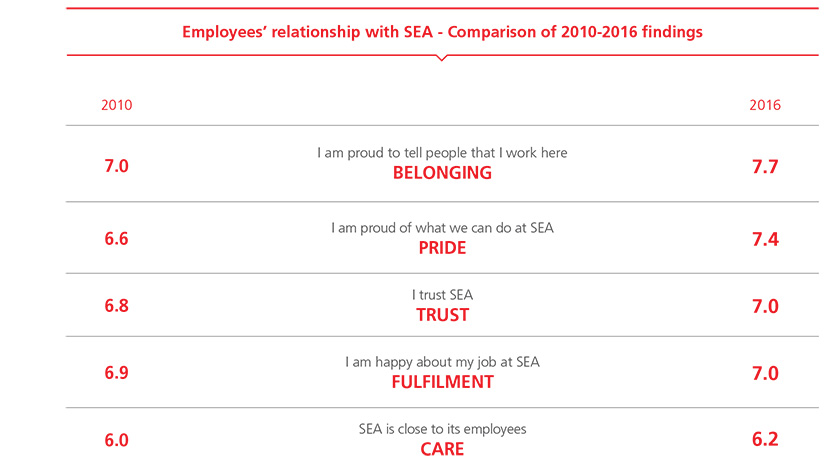
The more internal aspects of engagement, personal motivation (satisfaction with one's work), care and closeness remain stable.
We must point out that strengthening of relationship between the company and its people benefits particularly from SEA's reputation, i.e. external and market positioning that the company has gained over time.
Reinterpreting the data in relation to the socio-professional profile allows us to see how senior functions (executives and managers) and the more operational roles (workers) express greater positivity in their relationship with the company, while shift workers (category with a large concentration of white-collar workers) are more critical on average.
Similarly, people with more than 15 years of service express more frustration and dissatisfaction. There is no noticeable divergence between Linate and Malpensa employees, although Malpensa shows more unease on the issues related to trust.
Finally, younger people stand out for their overall more favourable approach, while women and more educated people have a more critical attitude.
Work-family reconciliation and occupational health indicators
Reconciliation is an important issue for employees involved in the survey, and SEA has been very engaged on this issue, although there is further room for improvement. A large majority of respondents (67%) recognize SEA's engagement in the field of reconciliation, which continues to represent an item with strong demand for investment, despite the non reconcilable objective organizational constraints.
Women, employees with children, blue-collar workers and shift workers appear more critical of the company's concrete desire to offer solutions to employee reconciliation needs.
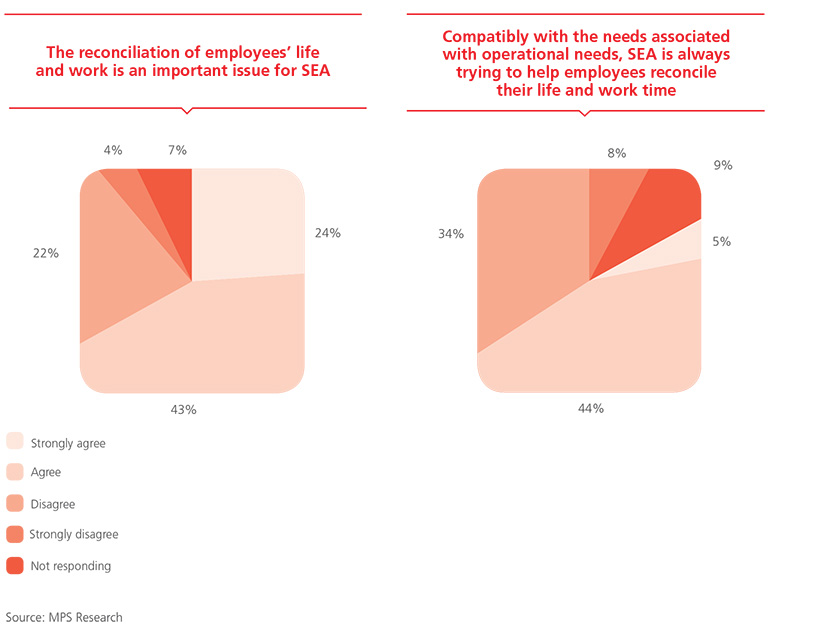
Most people find that their working time does not cause problems with family-work reconciliation (57%). However, a considerable percentage (36%) of respondents believe that working hours represent a major issue in the relationship with the company.
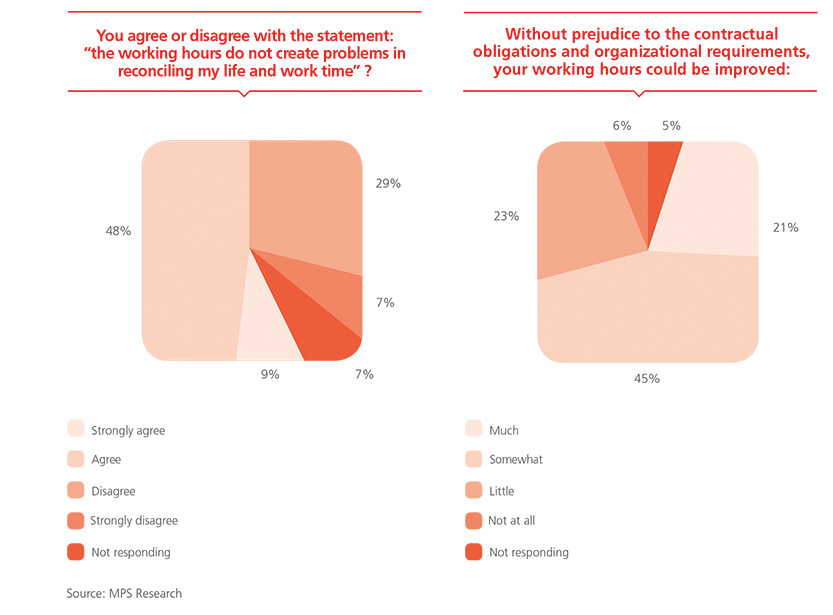
The evaluation of a set of workflow-related methods at SEA offers a satisfactory overall picture. Group work appears to be a positive and consolidated practice for a large majority of respondents (59%). Similarly, about half of the employees involved express a positive opinion about meeting schedules, work scheduling methods and tools, and people's interchangeability rate.
Some criticisms arise only in the field of work scheduling: in this field, the average satisfaction percentage is 51%.
Percentage among executives and managers is higher than the average (71%). Among the least satisfied we find blue-collars, whose assessments are inverse than the general sample (41% satisfied compared to 43% critical).
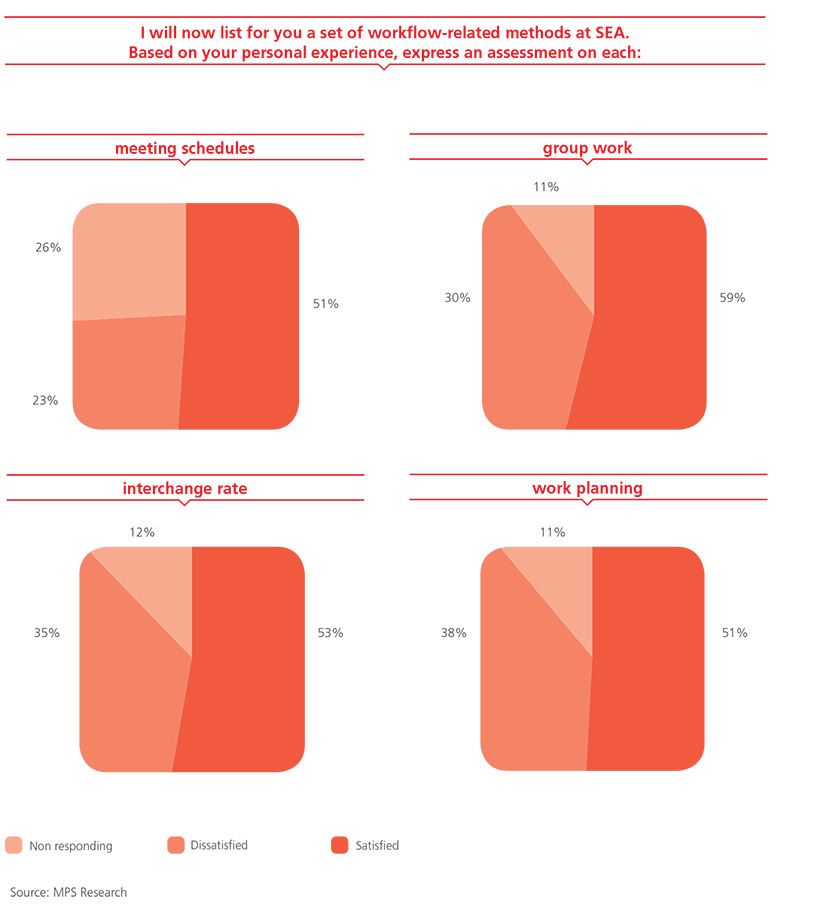
According to respondents, improving the workflow requires strengthening the relationship of trust between SEA and its people, together with a shared system for scheduling, prioritization and management of work. In both cases, the majority of respondents (54% and 52% respectively) highlights the need to strengthen the agreement between company and employees. This pact is based on the sense of responsibility that must characterize people's actions on one side, and delegation processes based on SEA's trust in its people on the other. The topic of trust and responsibility is particularly dear to more senior people and employees at Malpensa than to those at Linate.
On the topic of parental leave, it appears that 2 out of 10 respondents have made use of this tool during the last 5 years.
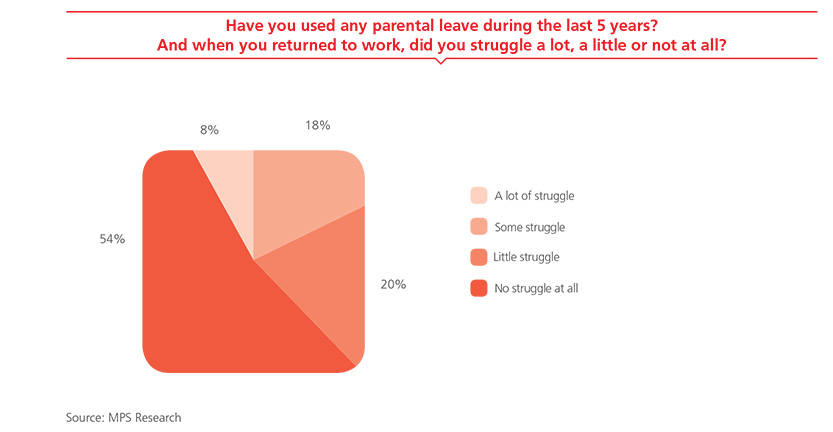
Most users were employees and families with three children. When returning from leave, a large majority had no difficulty (74%); the percentage of those who expressed critical issues was higher than the average among executives.
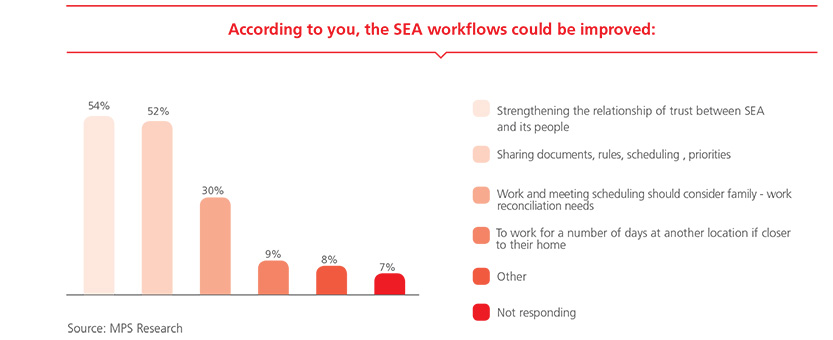
Sharing of documents, rules, and scheduling is mostly pointed out by executives and managers.
A small minority (30%), practical and pragmatic, especially employees with more than three children, cite their reconciliation needs. Finally, 9% of the respondents suggest the option for employees to work for a number of days a year at another location, if closer to their home.
Absenteeism
As confirmation of quality of our relationship with our people, we note how absenteeism rates remain stable at low values. At Linate, the trend for 2016 is in line with the previous year, while Malpensa records a slight decrease (from 3.78 in 2015 to 3.74 in 2016).
Interpreting data based on gender reveals an increase in the absenteeism rate only for male population (Linate from 3.45 in 2015 to 3.71 in 2016, Malpensa from 3.41 in 2015 to 3.59 in 2016). For female population, rate is falling (Linate from 4.55 in 2015 to 4.00 in 2016, Malpensa from 4.86 in 2015 to 4.15 in 2016).
Absenteeism rate by gender and location
| 2016 | 2015 | 2014 | |
|---|---|---|---|
| Linate | 3.80% | 3.79% | 3.71% |
| Women | 4.00% | 4.55% | 3.20% |
| Men | 3.71% | 3.45% | 3.94% |
| Malpensa | 3.74% | 3.78% | 4.45% |
| Women | 4.15% | 4.86% | 5.44% |
| Men | 3.59% | 3.41% | 4.09% |
| Other lacations* | 0.44% | 1.76% | 3.22% |
| Women | 0.18% | 4.00% | 3.39% |
| Men | 1.18% | 1.11% | 3.15% |
Source: SEA
Personnel at Rome Ciampino, Venice, Catania airports for 2014 and at Rome Ciampino and Venice airports for 2015.
Note: The absenteeism rate is calculated as follows: no. of days of absence/working days * 100.
Only employed personnel is included.
The absences included in the calculation are the unplanned ones (e.g., illness, accident), while the planned ones (such as holidays, maternity) are excluded.